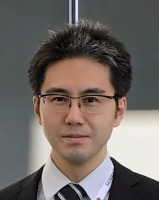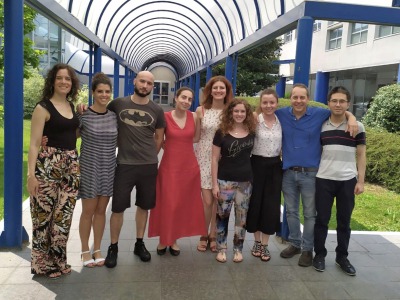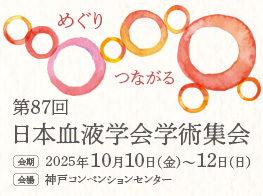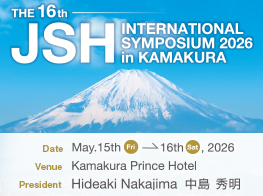.png)
EHA‒JSH Collaborative Exchange Program Award
Scientific Report
Awardee


Hiroshi Arima
Department of Hematology and Oncology, Graduate School of Medicine, Kyoto University
Research project
The role of the B cell antigen receptor in B-lymphoma immune surveillance and tumor niche imprinting
Host institution and laboratory where the project will be conducted
Genetics of B Cells and Lymphomas Unit, IFOM - The FIRC Institute of Molecular Oncology, Milano, Italy
Host supervisor/mentor of the project
Stefano Casola, MD, PhD
***************************
(1) Role of the BCR in immune surveillance of MYC-driven lymphoma cells
Although B-cell receptor (BCR) signaling inhibitors are expected to play a central role in the treatment of B-cell lymphoma, the mechanisms of response and acquisition of resistance by the tumor remain unclear. Moreover, some subgroups of high-grade B-cell lymphoma is known to proliferate even when BCR expression is down-regulated or absent. My project aims to elucidate how BCR signaling facilitates immune escape of B-cell lymphoma and how B-cell lymphoma, even in the absence of BCR, re-establishes a tumor microenvironment that is favorable for tumor growth in vivo.
Dr. Stefano Casola's lab at the host institution has established an experimental model of Myc lymphoma that allows us to follow the growth process of BCR-positive and BCR-negative tumors both in vitro and in mice by using TAT-Cre fusion proteins to eliminate BCR signaling. First, we compared the growth rate in vitro of BCR-positive and negative lymphoma cells isolated after TAT-Cre treatment, and showed that Myc lymphomas become capable of growing at the same rate as BCR-positive tumors in a very short period of time after complete loss of BCR. Next, when wild-type mice were inoculated separately with BCR-positive and negative lymphomas, it was found that, unlike the in vitro results, BCR-negative lymphomas can only grow at a slower rate than BCR-positive lymphomas, although BCR-negative lymphomas eventually begin to grow aggressively in mice. Interestingly, when NSG mice lacking T, NK, and B-cell immunity were inoculated with lymphoma cells, the in vivo difference in proliferation rate between BCR-positive and negative lymphomas was attenuated, suggesting, as expected, that the difference in immune response to lymphoma depending on the integrity of BCR is what drives the difference in proliferation rate between BCR-positive and negative lymphomas in vivo.
Next, using gene expression microarrays, flow cytometry and Western blotting, we compared BCR-positive and negative lymphoma cells cultured in vitro and showed that the expression of multiple genes and proteins involved in the regulation of the anti-tumor immune response and the construction of the tumor microenvironment was variable depending on the integrity of BCR. On the other hand, similar ex vivo analysis of lymphoma cells grown in mice showed that some of the molecules that differed in expression between BCR-positive and negative lymphomas lost the differences observed in vitro. These results suggest that BCR-negative lymphomas must rely on an unknown signaling pathway that bypasses BCR signaling to maintain molecular expression comparable to that of BCR-positive tumors in order to adapt and proliferate in the immunocompetent environment, and highlight the importance of analyzing the relationship between lymphoma and neighboring cells constructed in vivo as closely as possible as it is to elucidate the real mechanism of lymphoma progression.
(2) BCR contribution to spatio-temporal lymphoma dynamics in vivo
Then, in collaboration with Dr. Claudio Tripodo, professor of Tumor Immunology Unit, University of Palermo School of Medicine, we analyzed the relationship between tumor cells and various immune and stromal cells in murine bone marrow and lymphoid tissues by multiple immunostaining, and found that the periphery of BCR-negative lymphomas was more infiltrated with a specific kinds of immune cells than BCR-positive lymphomas. We are currently evaluating differences in immune and stromal cell activity that may be responsible for tumor elimination or assisting tumor progression, as well as performing RNA sequencing of lymphoma cells collected from mice to identify the molecules responsible for the differences in the tumor microenvironment between BCR-positive and negative lymphomas. Interestingly, the expression of key proteins known to be important in constructing the tumor microenvironment does not differ between BCR-positive and negative lymphomas proliferating in vivo, and an unreported mechanism may direct the differences in the tumor microenvironment between BCR-positive and negative tumors. We are going to analyze spatio-temporal lymphoma dynamics in vivo using multiphoton intravital microscopy evaluating bone marrow cavities and lymph nodes of tumor-bearing mice.
(3) Interaction and discussion in the 24th EHA congress
During my fellowship, I had the opportunity to attend the 24th European Hematology Association (EHA) Scientific Congress (13-16 June 2019) in Amsterdam, Netherland, with support from my host institution. At the conference, I had the pleasure of participating in discussions on the latest findings related to the progress of clinical trials of combinations of molecular targeted agents such as BCR inhibitors, BCR2 inhibitors, and EZH2 inhibitors for malignant lymphoma. I was also able to communicate with Dr. Gabriele Varano who, after a career as a postdoctoral fellow in Dr. Stefano Casola's laboratory, is currently working in the United States and has presented the results of his project related to FOXO1, which is considered to be a novel and important molecule involved in the tumorigenesis of B-cell lymphoma. I was also invited to a meeting with Dr. Pieter Sonneveld, EHA President, and young researchers from different countries, and was inspired by the enthusiasm of the young researchers and the well-organized European fellowship and co-education programs that support them. I have renewed my decision to continue contributing to the improvement of outcomes of patients with hematological malignancies by pursuing further research with novel approaches in the future.
(4) Acknowledgement
I would like to thank Dr. Stefano Casola and his group members for accepting me as a member of the group. I would also like to thank Dr. Claudio Tripodo, Dr. Alessandro Gulino and Dr. Valeria Cancila at University of Palermo School of Medicine, and Dr. Fabio Facchetti at University of Brescia for their invaluable collaboration in immunohistocheminal analysis. I am grateful to Mio Sumie and Marina Properzi at The FIRC Institute of Molecular Oncology for their great hospitality during my stay. I am grateful to Dr. Akifumi Takaori and Dr. Momoko Nishikori at Kyoto University for their generous support. Finally, I thank EHA and JSH for giving me the opportunity to have this invaluable experience.

With lab members at the hosting institute (second from right is Dr. Stefano Casola and the rightmost is the grantee)
©THE JAPANESE SOCIETY OF HEMATOLOGY



